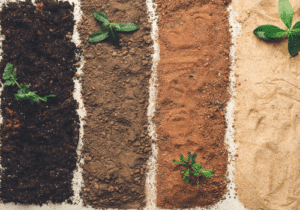
Substrate Compatibility Guide
Selecting the right substrate is a key element in successful
RECEIVE 10% OFF ON YOUR FIRST ORDER! – USE CODE: WELCOME10
A full list of the contents is included in your grow kit, but let’s go over each item to make sure that you have everything you need to get growing.
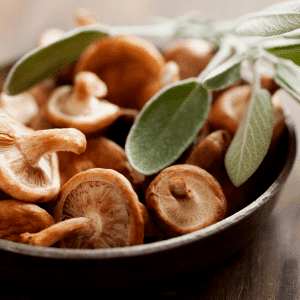
Are you ready to start growing your own block of shiitake mushrooms? Then let’s get started!
Inoculation means to add a culture into a growing medium – in this case, you will be adding your liquid culture into the rye grains in the lower portion of your kit where the X is marked on the picture below.
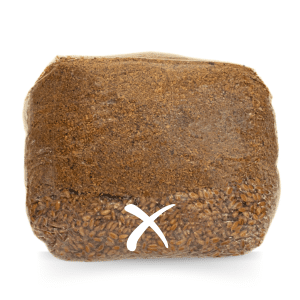
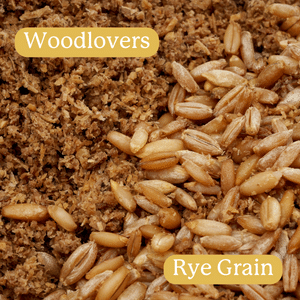
Not too sure how to complete this process? Watch the video below to see how we do it.
Patience is the hardest part of growing mushrooms. The excitement and anticipation will grow as you watch the white threads of mycelium growing through you kit.
For this stage of growth, you are aiming to get the mushroom mycelium growing through all the grains – don’t worry, the mushrooms will know which way to go to find the grains. Grains are packed full of nutrition and are the perfect food to start growing mushrooms on. Think of the grains as baby food and the hardwood substrate as adult food. Mushrooms will need as much nutrition as possible while they are establishing themselves before moving onto a different food source: wood. Below you can see the white mycelium starting to grow on the grains.
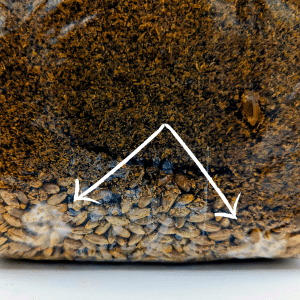
Keep the bag upright and follow these tips to get the best growth from your mushrooms:
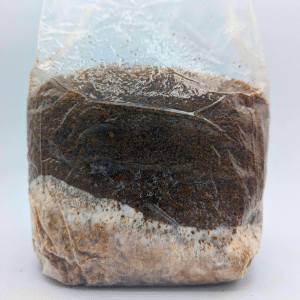

Shiitake mycelium takes about a month to fully colonize both the grains and the wood substrate. During this time the mycelium will become thick and white and have a sponge-like texture as it continues to mature. The relatively smooth surface of the grow kit will start to form white lumps, which resemble popcorn, hence the term “popcorning”. “Popcorning” is a term used in mushroom cultivation to describe the change in appearance of the shiitake mushroom block. All of this occurs inside the bag without needing additional prompting in the second month of incubation. The more lumps your block develops, the bigger the harvest! Below is a good example of a mushroom block “popcorning”.
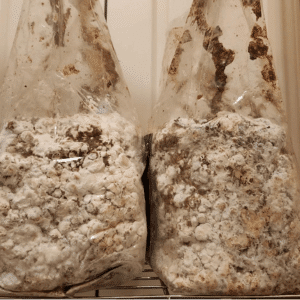
Browning” occurs in the third month of cultivation. The white, popcorned mycelium will slowly start to turn a dark brown, similar to the bark on a log. Your mushroom block will start to take on a cork-like texture. You may even notice some golden to dark-brown colored liquid developing. All of this is absolutely normal and a very good sign for your future harvests. When your block is 80-90 % browned, you can move onto the fruiting stage.
Quick note: You can start the fruiting process when the block is still white with flecks of dark brown, but the yields are unpredictable when you choose to do this. We recommend remaining patient and waiting for the block to fully mature.
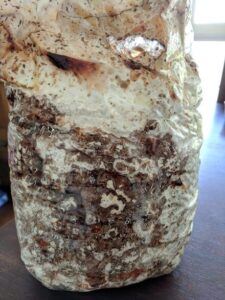
Fruiting is the phase of growth in which visible mushrooms begin to appear on your kit. Shiitake mushroom mycelium is triggered into the fruiting stage by a few factors: full colonization of the growing medium (kit), vibration, temperature change and an increase in fresh air. This is the most exciting stage of cultivation and can seem like the most complex, but we’re here to guide you through it.
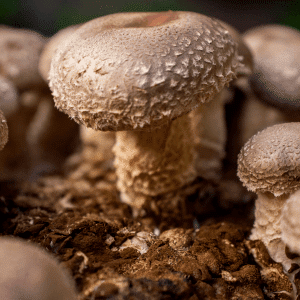
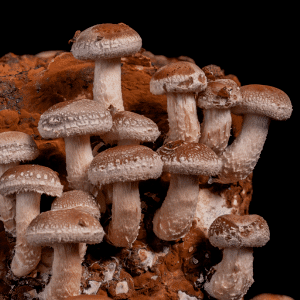
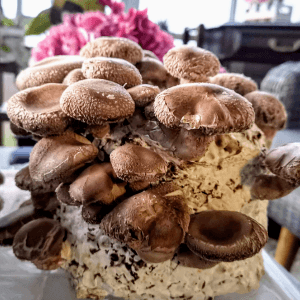
Knowing when to harvest your mushrooms is a quick skill to learn. It is very tempting to let your mushrooms grow for longer than they should. We are big advocates for experimentation so if this is your first time growing and you simply want to see how big they can grow then by all means have some fun and try it out. Keep in mind that if shiitake mushrooms are harvested past their prime, their stems will become very rubbery and unpleasant.
If you want to harvest your mushrooms at their prime for cooking then follow the steps below.
When the edges of your mushrooms look like the image below, you are ready to harvest. Use scissors or a knife to cut through the base of the mushroom stem, close to the substrate, to harvest your mushrooms.
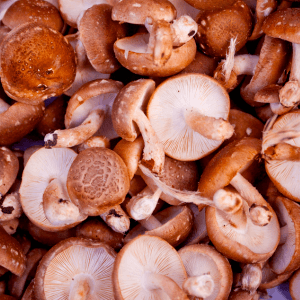
Once you’ve harvested your mushrooms, you’ll be able to get a second harvest or “flush” of mushrooms. Mushrooms can continue to grow as long as they have all of the requirements for growth such as: water and nutrition. The Myterra Labs Easy Mushroom Grow Kit has more than enough of both to sustain your mushrooms for a second round of mushrooms to form. Here’s what you need to do:
Mushroom blocks typically produce fewer and fewer mushrooms with each harvest as nutrients are depleted.

Well done! You’ve successfully grown your own mushrooms. The options for what to do next are endless.
If you would like to increase the amount of vitamin D in your mushrooms, leave the harvested mushrooms in the sun for 15-30 minutes. That’s all it takes!
Cooking: There are numerous ways to cook shiitake mushrooms with an abundant number of recipes online. We recommend cooking these mushrooms on a high heat pan without oil. When the mushrooms start to turn brown or stick to the bottom of the pan, add in your oils/butter and garlic. These mushrooms can compliment any dish with their umami flavor.
Long term storage: If you grow multiple kits at once or if you’re going away for a week, you can dry your harvested mushrooms. Airdry at 115F for 24-28 hours or until they are dry enough to snap apart. Store in an air-tight container for up to 6 months. Dried mushrooms can be rehydrated in a bowl of water for 30 minutes before use or they can be ground into powder to add to soups and stews.
You are officially part of the mushroom growing community! Share your success on social media and follow us for more mushroom growing tips and tricks – there are so many mushrooms that you can test your new growing skills on!
If you liked growing shiitake mushrooms and want to expand your medicinal mushroom growing skills, we suggest growing Lion’s Mane mushrooms.
Lion’s mane mushrooms are creamy and pom-pom shaped with dense flesh. Our lion’s mane strain produces large mushrooms in 4-5 weeks. Lion’s mane mushrooms are easier to grow than the shiitake.
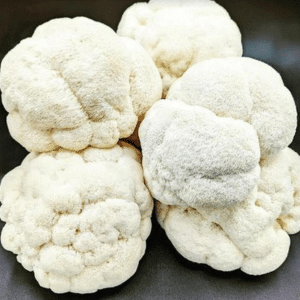
A full list of the contents is included in your grow kit, but let’s go over each item to make sure that you have everything you need to get growing.

Are you ready to start growing your own block of shiitake mushrooms? Then let’s get started!
Inoculation means to add a culture into a growing medium – in this case, you will be adding your liquid culture into the rye grains in the lower portion of your kit where the X is marked on the picture below.


Not too sure how to complete this process? Watch the video below to see how we do it.
Patience is the hardest part of growing mushrooms. The excitement and anticipation will grow as you watch the white threads of mycelium growing through you kit.
For this stage of growth, you are aiming to get the mushroom mycelium growing through all the grains – don’t worry, the mushrooms will know which way to go to find the grains. Grains are packed full of nutrition and are the perfect food to start growing mushrooms on. Think of the grains as baby food and the hardwood substrate as adult food. Mushrooms will need as much nutrition as possible while they are establishing themselves before moving onto a different food source: wood. Below you can see the white mycelium starting to grow on the grains.

Keep the bag upright and follow these tips to get the best growth from your mushrooms:


Shiitake mycelium takes about a month to fully colonize both the grains and the wood substrate. During this time the mycelium will become thick and white and have a sponge-like texture as it continues to mature. The relatively smooth surface of the grow kit will start to form white lumps, which resemble popcorn, hence the term “popcorning”. “Popcorning” is a term used in mushroom cultivation to describe the change in appearance of the shiitake mushroom block. All of this occurs inside the bag without needing additional prompting in the second month of incubation. The more lumps your block develops, the bigger the harvest! Below is a good example of a mushroom block “popcorning”.

Browning” occurs in the third month of cultivation. The white, popcorned mycelium will slowly start to turn a dark brown, similar to the bark on a log. Your mushroom block will start to take on a cork-like texture. You may even notice some golden to dark-brown colored liquid developing. All of this is absolutely normal and a very good sign for your future harvests. When your block is 80-90 % browned, you can move onto the fruiting stage.
Quick note: You can start the fruiting process when the block is still white with flecks of dark brown, but the yields are unpredictable when you choose to do this. We recommend remaining patient and waiting for the block to fully mature.

Fruiting is the phase of growth in which visible mushrooms begin to appear on your kit. Shiitake mushroom mycelium is triggered into the fruiting stage by a few factors: full colonization of the growing medium (kit), vibration, temperature change and an increase in fresh air. This is the most exciting stage of cultivation and can seem like the most complex, but we’re here to guide you through it.



Knowing when to harvest your mushrooms is a quick skill to learn. It is very tempting to let your mushrooms grow for longer than they should. We are big advocates for experimentation so if this is your first time growing and you simply want to see how big they can grow then by all means have some fun and try it out. Keep in mind that if shiitake mushrooms are harvested past their prime, their stems will become very rubbery and unpleasant.
If you want to harvest your mushrooms at their prime for cooking then follow the steps below.
When the edges of your mushrooms look like the image below, you are ready to harvest. Use scissors or a knife to cut through the base of the mushroom stem, close to the substrate, to harvest your mushrooms.

Once you’ve harvested your mushrooms, you’ll be able to get a second harvest or “flush” of mushrooms. Mushrooms can continue to grow as long as they have all of the requirements for growth such as: water and nutrition. The Myterra Labs Easy Mushroom Grow Kit has more than enough of both to sustain your mushrooms for a second round of mushrooms to form. Here’s what you need to do:
Mushroom blocks typically produce fewer and fewer mushrooms with each harvest as nutrients are depleted.

Well done! You’ve successfully grown your own mushrooms. The options for what to do next are endless.
If you would like to increase the amount of vitamin D in your mushrooms, leave the harvested mushrooms in the sun for 15-30 minutes. That’s all it takes!
Cooking: There are numerous ways to cook shiitake mushrooms with an abundant number of recipes online. We recommend cooking these mushrooms on a high heat pan without oil. When the mushrooms start to turn brown or stick to the bottom of the pan, add in your oils/butter and garlic. These mushrooms can compliment any dish with their umami flavor.
Long term storage: If you grow multiple kits at once or if you’re going away for a week, you can dry your harvested mushrooms. Airdry at 115F for 24-28 hours or until they are dry enough to snap apart. Store in an air-tight container for up to 6 months. Dried mushrooms can be rehydrated in a bowl of water for 30 minutes before use or they can be ground into powder to add to soups and stews.
You are officially part of the mushroom growing community! Share your success on social media and follow us for more mushroom growing tips and tricks – there are so many mushrooms that you can test your new growing skills on!
If you liked growing shiitake mushrooms and want to expand your medicinal mushroom growing skills, we suggest growing Lion’s Mane mushrooms.
Lion’s mane mushrooms are creamy and pom-pom shaped with dense flesh. Our lion’s mane strain produces large mushrooms in 4-5 weeks. Lion’s mane mushrooms are easier to grow than the shiitake.


Selecting the right substrate is a key element in successful
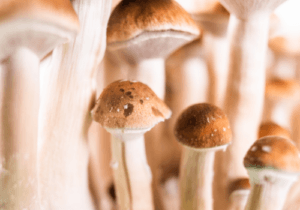
Welcome to the enchanting realm of our All-in-one Grow Kit,
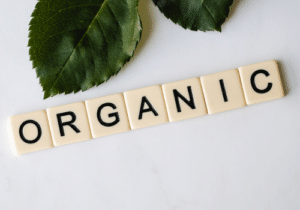
Mushrooms are a popular ingredient in many dishes around the
© 2023 Myterra Labs. Designed by Laura Ramsay. Developed by Info2grow Media Services.